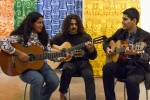The UCLA Guitar Ensemble will be playing old music in a new setting as part of the Fowler Out Loud series.
Members of the ensemble will showcase Latin American music at Fowler Out Loud, a concert series in which UCLA students perform at Fowler Museum. The group’s performance, which will be held Wednesday at 6 p.m., is in collaboration with the exhibit, “Axé Bahia: The Power of Art in an Afro-Brazilian Metropolis,” which highlights the cultural identity of the Brazilian city of Salvador. Hanna Yocuté, a member of the ensemble said the performance will try to connect the exhibition’s artworks with Latin American music.
“Axé Bahia … it basically means is ‘natural sounds,’ and it’s pretty cool we get to (perform) because our instruments are natural sounding,” said Yocuté, a fourth-year music student.
Yocuté said the ensemble is showcasing a mix of group performances, duets and solo performances in Brazilian and Latin music, as well as playing instruments that come from Latin America, like the classical guitar. Since many of the listeners tend to not know the context in which art and music is made, Yocuté said, the guitar ensemble will try to bridge the gap between the history of the songs and the music itself by explaining background details of the songs, such as the composer or the meanings behind the lyrics.
Yocuté will perform an Afro-Cuban song, “Drume Negrita” – Spanish for “go to sleep little black girl.” She said even though the song originates from a lullaby, people tend to play the song fast to show off their technical skills.
“When you research what this song is actually about – which I think is really important for a musician to do – you learn the lyrics,” Yocuté said. “It’s about a mother who wants her baby to sleep.”
Aaron Dozal, a third-year music student said learning songs like “Drume Negrita” can be a technical challenge. The performances often require hours of practice and new techniques, such as learning how to play new guitar chords.
“A lot of songs composed by Brazilian composers are adaptations of lullabies, so there’s a lot of in between,” Dozal said. “Someone has to arrange it for the guitar, and you don’t know what kinds of processes are going on in between there.”
Joseph Stefan, a first-year music student and a member of the ensemble, said creativity and technique also connect all areas of art to each other. One of the pieces he will perform is by Brazilian composer Heitor Villa-Lobos in the choro style of music, a Brazilian jazz-influenced street musical form that mixes different music styles and cultures.
“I feel like when you look at a piece of artwork, and there’s a musical piece that either represents the same emotions as the work of art or the same time period, it offers a more complete point of view of whatever the artist is trying to show the audience,” Stefan said.
Similarly, Juan Rivera, a graduate student in classical guitar performance, said both the artwork and music is a mixture of techniques and ideas about culture and identity through various mediums. However, they connect to bring an audience together.
Rivera will play two duets in the performance. One is a mixture between Latin and flamenco styles reminiscent of Latin jazz, which involves more strumming and rhythmic melodies. The second duet is a tango piece written by Argentinian composer Astor Piazzolla – a piece that hints at Afro-Cuban, Brazilian bossa nova and European influences.
“There’s a lot of colors, a lot of textures and rhythms. They’re all epitomizing the Latin American feel and the influences there,” Rivera said. “All the pieces my colleagues and I are playing all embody some of the style. Sometimes it’s subtle, sometimes it’s very in-your-face.”
Rivera said he hopes the music the guitar ensemble plays will not just expose listeners to new music, but also help them understand the way in which they are meant to be perceived.
“It’s very nice for me to show people that this type of music exists, that it’s very fun, that it’s celebratory and very communal and social,” Rivera said. “Flamenco and mariachi … are all played when … there’s a lot of people that want to hear it and want to dance to it.”
